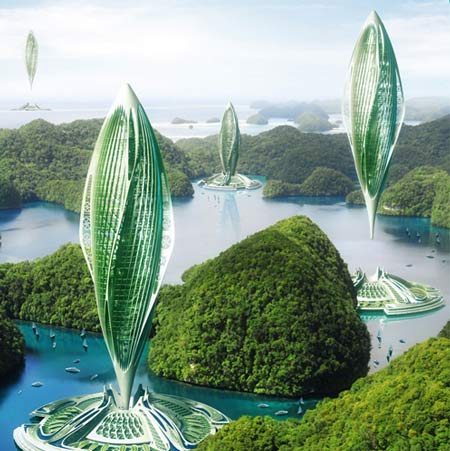
Belgian architect Vincent Callebaut has designed a conceptual transport system that would involve airships powered by seaweed.
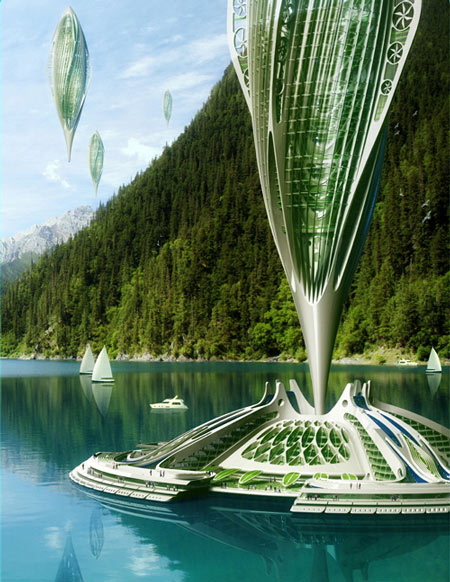
Called Hydrogenase, the project envisages that by 2030 there could be farms in the ocean producing biofuel from seaweed and acting as hubs for the aircraft.
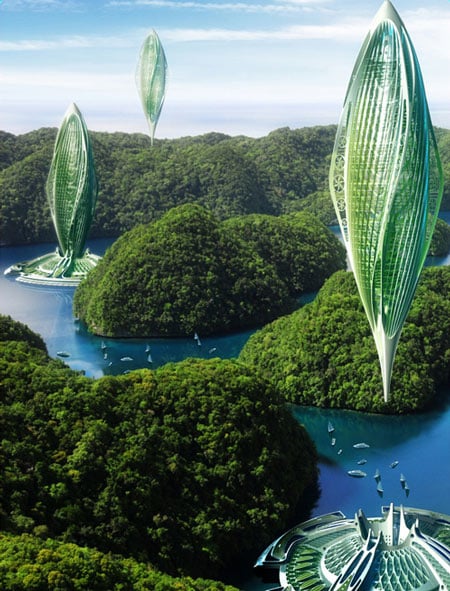
Here’s a lot of text from Callebaut:
“HYDROGENASE”
ALGAE FARM TO RECYCLE CO2 FOR BIO-HYDROGEN AIRSHIP
Between engineering and biology, Hydrogenase is one of the first projects of bio-mimicry which draws its inspiration from the beauty and the shapes of the nature, but also and especially from the qualities of its materials and its self-manufacturing processes. The new green revolution is really in progress and enables us to design the air mobility of the foil after shock, 100% self-sufficient in energy and zero carbon emission! This inhabitated vertical aircraft inaugures a clean and ethic mobility to meet the needs of the population en distress touched by the natural and sanitary catastrophes, and all that without any runway! Its architecture is subversive and fundamentally critic towards the ways of living of our contemporary society that we have to reinvent totally! Let’s take off thanks to biofuels and let’s propel to the eco-responsible transport of the future!
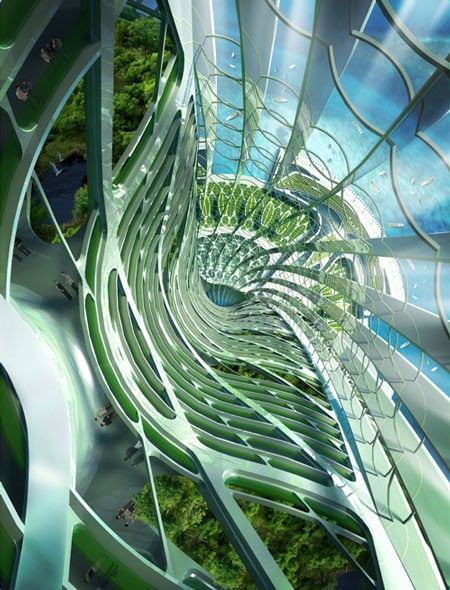
2015: Biofuels of the 3rd generation, the challenge of a sustainable mobility
The price of the fuel has just reached a new historical record by passing 75 dollars the barrel in 2010. Within 10 years, we could reach the famous “Hubbert Peak”, the precise moment from which the worldwide fuel production will begin to decrease because of shortages. In such a context, the massive resort to renewable energies and nanotechnologies, that do not emit gas with greenhouse effect, is becoming an absolute economical, technological and political priority! From Queensland’s university to the Karlsruhe’s one, going through Berkeley in California, the « third generation » biofuels are in gestation and will revolutionize our future sustainable land or air mobility. Their main strengths: they do not compete either with the food cultures nor with the forest spaces and can be developed naturally everywhere in the world even in arid territories, the whole tending to a targeted bio-remediation of the industrial CO2.
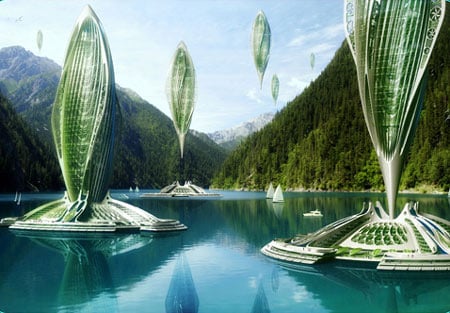
Able to produce electricity and biofuel without emit CO2 or other polluting substances, the hydrogen especially is nowadays such as a very promising clean energy source. Therefore (its production that respects the environment and in sufficient quantity) is a study theme that interests the biggest scientific international groups. Actually, at the end of the 90s it has been discovered that the private sulphur micro-seaweeds go from the oxygen production (classical photosynthesis) to the hydrogen production. Such as a growing tree uses the solar radiance to manufacture organic material, we aim today at producing by photosynthesis some dihydrogen (i.e. gaseous hydrogen) from living micro-organisms as seaweeds from the « Chlamydomonas reinhardtii » family that owns enzyme of hydrogenase type.

According to biologists, the output obtained by a farm with micro-seaweeds would be superior to those made currently with farming means to produce biodiesel or bioethanol. This could be estimated at 1000 litres of hydrogen for 330 grams of chlorophyll per day whereas for example colza produces roughly only 1000 litres of oil per hectare. According to industrials a hectare of seaweeds could thus produce organically 120 times more biofuels than a hectare of colza, soya or sunflower.
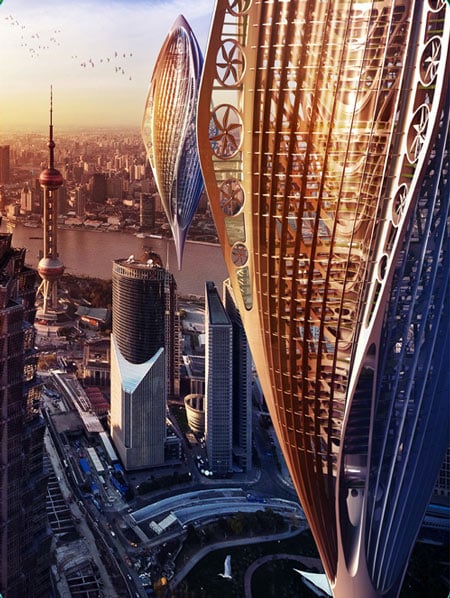
Moreover, a farm with seaweeds is a true miniature biochemical power station able to absorb CO2 as main nutrient by photosynthesis accelerated by producing hydrogen in vitro or in bioreactors. This natural process, nourishing itself with our waste enables thus to recycle under the effect of the sun, in seaweeds or sea water baths, up to 80% of carbonic gas and NOx (nitrogen oxides also very impacting on the greenhouse effect). The global organic cycle enables therefore to revaluate our carboned rejections such as for example those are coming from filters with particles of our cars, reactors of our airplanes or also our rockets coming from thermal power stations with coal or gas.
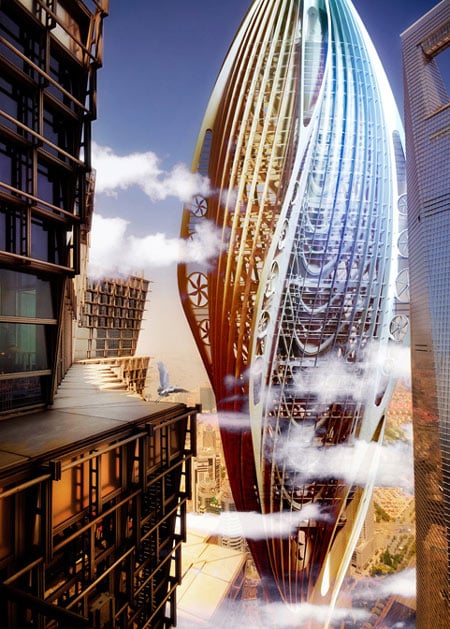
2020: Towards an aerial revolution and agree generation of airships?
The builders of airplanes get involved at maxima until 2020 according to an international agreement to be less polluting (reduction by 80% of their rejection in nitrogen oxides), to be thriftier in fuel (reduction of 20% of the fuel quantity by carried passenger) and finally to be more silent (reduction of 10 decibels, i.e. twice less noise). But what will happen when there will be no more fuel? The end of air freight in 2030 ? According to forecasts, every year from 2010, 200 billion of Chinese people will fly to spend holidays abroad. After the last born A380 of Airbus and the 777-200LR of Boeing, the airplanes of the future will not have such as their previous energy-consumers to be designed without taking into account the notions of sustainable development and the respect of the environment. A theme totally ignored fifteen years ago in this sector! This transport must be eco-designed from renewable energies and present a statement of carbon emission equal to zero!
No airplane, no helicopter, no aircraft, the project « Hydrogenase » marks a new generation of state-of-the-art hybrid airships. It is dedicated to humanitarian missions, rescue operations, installation of platforms for scientific studies, and of course to air freight. Then, complementary activities could be entertainment, eco-tourism, hotel, human transports, air media coverage and territorial waters surveillance.
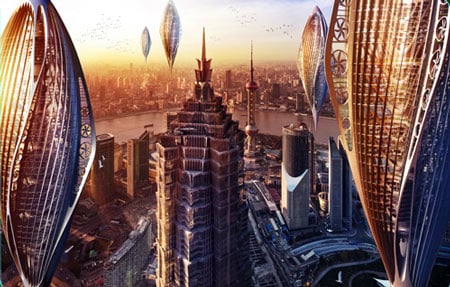
This mode of transport is certainly less interesting than the piggyback or sea freight and slower than airplane; however it needs less infrastructure and multimodal platforms (runway, freeways, ship/truck alternation…). It consumes thus less territory and will progressively enable to heal our landscapes slashed by the transport network leading to a massive deforestation. Therefore, it costs 10 times less for the carriage of heavy loads as well as traveller transport, and everything without damaging the planet! For the specialists of logistical transport facing the long lasting absence of appropriated road or airport infrastructures in many parts of the world (desert and oceans), this new generation is also very expected to link production sites and using sites. Moreover, flying free health care centres or even country hospitals could also interfere during natural catastrophes, where lives could be in danger. It could also explore and help underprivileged territories of the third world by carrying the raw materials of our globalised alimentation to those who are hungry in remote places!
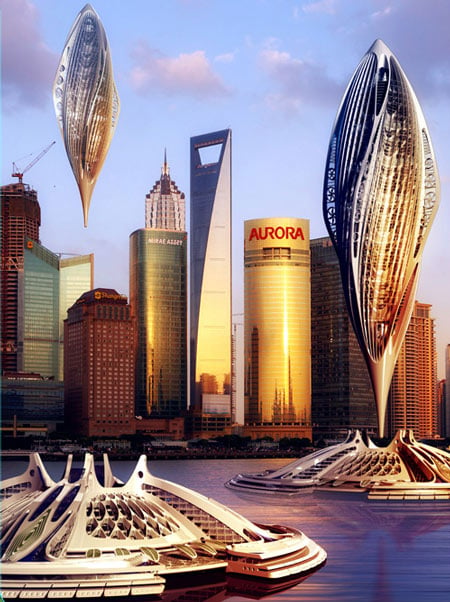
Hydrogenase is thus a jumbo jet vessel (DGP) that flies at an average of 2 000 meters high. This cargo measures almost 400 meters high for 250 000m3. It can carry up to 200 tons of freight at 175 km/h (i.e. twice the speed of a ship and more than one and a half time than the one of a truck). Seven times slower than an airplane, it has an action potential between 5 and 10 000km and re-teach our contemporary travellers the long time of sea cruises and the praise of the slowness. The history of the transports which was until now summarized in a study that reveals to always go faster, is soon finished for the benefit of “better travel” in airship!
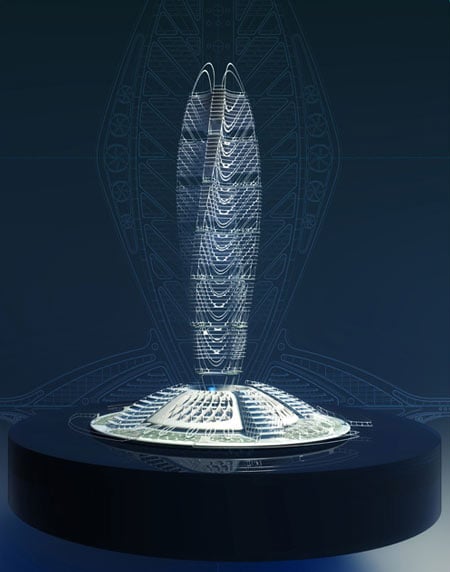
2030: Hydrogenase, the 100% self-sufficient organic airship of the future
The project Hydrogenase brings to question the « always faster » of our frenetic society and thinks differently to the mobility and services. With bionic look, this inhabited vertical airship sets in the heart of a floating farm of seaweeds that reload it directly with bio-hydrogen. These two interdependent entities are both nomad and organic, the first one flies in the sky and the second one on the seas and oceans.
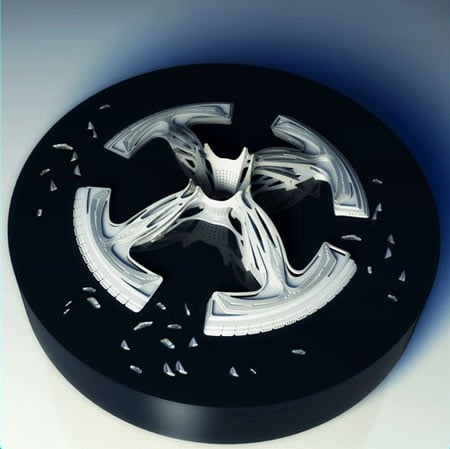
The proactive ship flourishing in the air :
The semi-rigid not pressurised airship stretches vertically around an arborescent spine that air-dynamically twists on more than 400 meters high and 180 meters of diameter. Forming a big flower ready to open, the spaces divide in cross under the shape of petals that welcome respectively the main sectors of activities: housing, offices, scientific laboratories and entertainment. The stem around the one these functional petals structure themselves, welcome the vertical circulations, the technical premises and the goods warehouses for the freight.
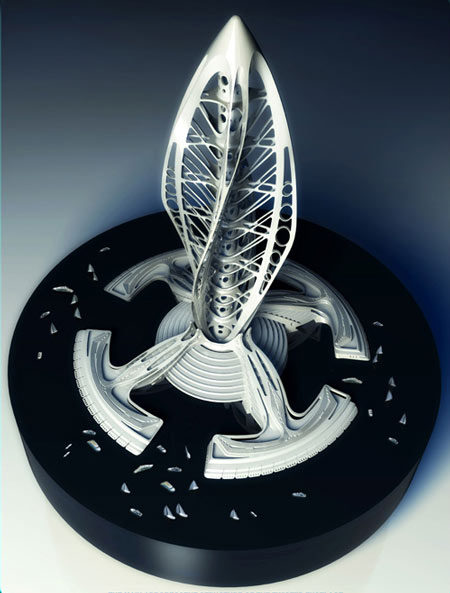
These 4 inhabited spaces are included between 4 great bubbles inflated with bio-hydrogen, a renewable energy. These bubbles are made with a rigid hull in light alloy shaped with twisted longitudinal beams linked together by wide sinusoidal rings. Every end is finished by a cone, and the one at the bottom, the most sharpened one carries the stabilizers and the rudders of deepness and of direction. This framework is covered by a double layer of waterproof, fireproof, glazed canvas to reduce the resistance to advancement. The in-between is divided into slices in which there are small balloons full of helium. The helium mattress in periphery enables to protect the balloons of bio-hydrogen and helium, the remaining 30% are provided by the aerodynamic of the airship twisted fuselage with the speed, as for an airplane.
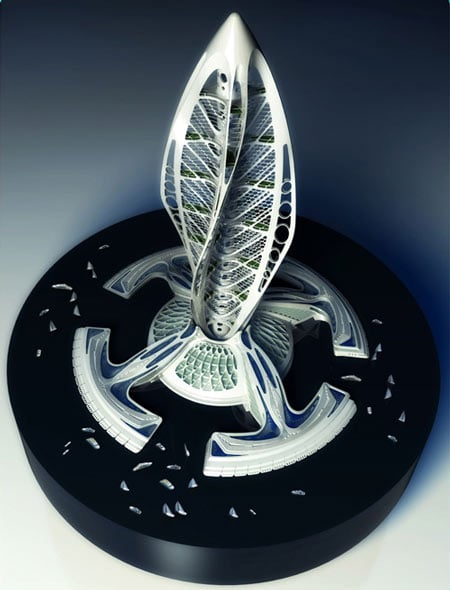
This type of airship is of course heavier than a flexible aerostat of same cubing because of the weight of the structure, but it can reach higher speeds, thanks to the solidity of its hull in titan, and carry more tons thanks to the ability to build always bigger layers (10000 m3 in 1900, 70 000 m3 in 1924 and 200 000m3 in 1938, 250 000 m3 in 2010). What distinguishes also such a machine from classical aircrafts from the past is that this one is heavier than the air and flies thanks to the Archimedes’ thrust (that does every balloon or aircraft), to helixes or at its subtle twisted aerodynamic that enables to reduce the oscillations of the limited layer. The fact that it is heavier than the air enables actually descents faster without having especially to eject gas. Moreover, the sustentation is based on the compression and the decompression of the biogas. Hydrogenase can thus be lighter or heavier according to the wished needs and the height.
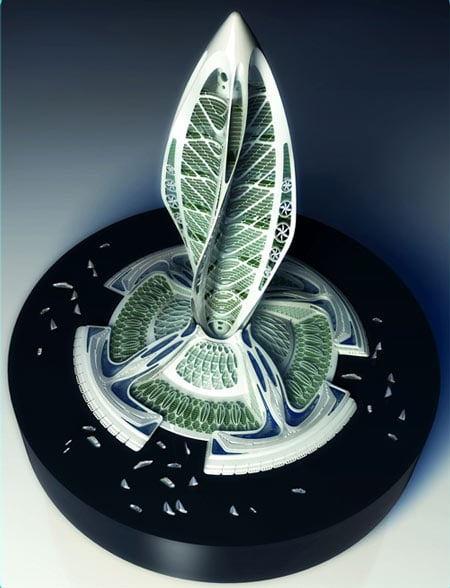
In order to build a proactive airship with positive energy, we also have integrated all the renewable energies. Actually, whereas the inflatable bubbles are glue-backed with flexible photovoltaic cells the four wings of the vessel are each of them inlayed with turbo-propellers with recuperation of energy. These 20 wind propellers are articulated around orbital rings which enable them to go from the horizontal position at the take-off to the vertical position assuring the vessel a navigation speed of 175km/h. The inhabited spaces integrate by steps vegetable gardens photopurifyng the used waters, the biomasses damaging the organic waters and loaded fuel cells. Nothing is lost, everything is recycled and transformed!
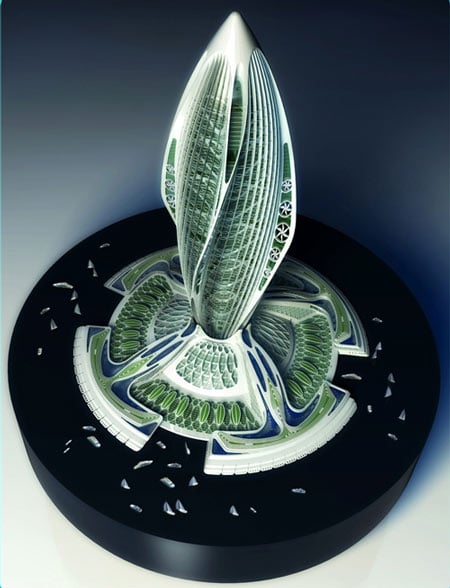
On top of absorbing the solar energy, this flying castle draws its inspiration from the biomimicry technologies and is built in lighter and more resistant composite materials (fibreglass and carbon fibre) in order to reduce the weight of its structure at the maximum. The fitting is thus self cleaning, in nanostructured glass inspired from the lotus leave that does not get wet. The vessel is thus made of « intelligent layers » avoiding for example the accumulation of ice or snow and « self-separable ceramics » offering a bigger resistance to the split and that fill the cracks. This bionic coating draws also its inspiration from shark skin that enables without being toxic to avoid the adhesion of bacteria whereas the four wings present irregularities of surface, as the finely beaded whale fins do, in order to reduce the turbulences. The green industry meets thus through this bionic prototype the expectations of the consumption, the always more demanding antipollution regulation and the rarefaction of resources.
The floating organic farm on seas and oceans:
The floating farm is a true organic purifying station composed of 4 carbon wells in which the green seaweeds recycle our carbonated waste brought by ships. This is directly dedicated to feed organically in biohydrogen the proactive airship. It replaces thus the petrol station as the runway for traditional airplanes and looks like a weaving of fine amphibian laces!
Actually, it sets up as much underneath as on top of the sea surface and respects the quadripartite sharing out in petals of the whole Hydrogenase project. Continuing the 4 wings of the pneumatic tower, 4 great arches structure this circular platform and distribute vertically all the levels of the central ring inhabited by the scientists. At the surface, these arches are covered by thermal and photovoltaic solar shields whereas under the water they are set with 32 hydro-turbines transforming the tidal energy of the sea streams into electricity.
Energically self-sufficient, this farm organises on a radiant plan, the seaweed bioreactors exposed to the zenith sun under the lenticular accelerators for a better photochemical output. The whole set forms four gardens dedicated to the accelerated photosynthesis where we access through marinas setting the exchanges between this true new floating city and the surrounding coasts. On top of producing clean energy, this floating purifying station is also an incredible observatory of the sea fauna and flora that fight for the protection of ecosystems and for the revitalization of the beds of corals and of endangered species. It is a true cleaner of seas and oceans by skimming and damaging as main nutrient the floating waste banks of our energy-consuming civilisation.
Hydrogenase is thus a project of environmental resiliency that will enable to invent a clean mobility according to a « cradle to cradle » cycle respecting our planet by assuring also the technological evolution of the human adventure ! As biotechnological prototype, it aims at being the symbiosis of men actions and their positive impacts on the nature. By imitating the processes of natural ecosystems, it deals with reinventing the industrial, town-planning and architectural processes to produce clean solutions and create an industry where everything is reused, either back to the ground under the shape of not toxic « organic nutrients », or back to the industry under the shape of “technical nutrients” able to be indefinitely recycled.
No comments:
Post a Comment